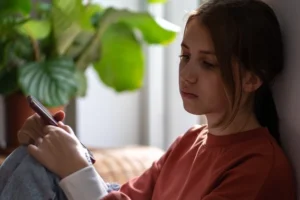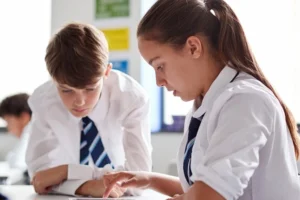Mobile phone is an essential tool for kids
“It’s been such a fast learning curve since Maddie went into year 7,” says Helen. “All her friends had phones and they were going into town, shopping or to the cinema, and Maddie having a phone felt like an essential security manager.”
As it happened, Maddie was one of the first girls in her social group to have a phone. “Maddie has Type 1 diabetes, which is tricky to manage at any age, so for a young girl with such an active social life, we felt it was important she be able to contact us for advice whenever she needed to.“
Stranger danger
To begin with, Helen’s biggest worry was probably “stranger danger” and the risk that predators could approach Maddie. “We locked down location services and set privacy controls on all her apps,” she explains.
Soon after starting secondary school, Maddie asked for an Instagram account and Helen agreed. “We made sure it was set to private, and only accepted follow requests from people she knew in real life.”
Staying safe on social and on the move
Helen also offered some tips on using Instagram appropriately, like never posting anything that identified her location, and no pouting! “More than the only accounts, I was concerned with how she used her phone,” adds Helen. “I’d seen children walking to school with ear-buds in, gazing at screens while they crossed the road, oblivious to the risks! I heard stories of people having their phones snatched, so I gave Maddie strict rules that her phone should stay in her bag until she was home.”
School rules on mobile devices
Maddie’s school has strict rules on technology, and does ask students to bring in a tablet for use in lessons. Helen has found this a really positive way to help children learn how to use the Internet for research, and apps to manage their work. But there are downsides. “The children are online with apps in school, and it can be open to misuse. Although the school takes a hard line on students misusing devices, it does happen. And kids are incredibly impressionable at that age, and want to follow the crowd.”
At one stage, Helen deleted gaming apps from Maddie’s phone, and changed passwords so that Maddie needed permission to download anything new. “It’s worked pretty well, and although I trust her to be responsible, I think it’s removed the distraction of temptation.”
Top online safety tips
Helen’s top tips for parents facing that year 7 transition are to think about how to help your child cope with peer pressure. “The main issue for me is how to deal with the things their friends and wider peer group are doing online,” says Helen. “My daughter’s social life exploded once she started secondary school, and I was taken aback by the variety of parental supervision, and posts other children found acceptable. We had to have some tricky conversations with Maddie.”
Helen and her husband are reassured by the school’s strict rules on device usage, with isolations and detentions issued even for first offences. “Maddie switches her phone off at the gate, and if she needs to contact me, she goes to the office,” says Helen. The school routers also block sites such as Instagram and Snapchat.
Being prepared and building trust
Looking back, Helen confesses she was woefully underprepared for the transition to secondary school and the digital experiences that it would bring. “I was so hit by it that I went through a phase of policing her phone most evenings, checking texts and social apps,” says Helen. “She was quite upset with me invading her privacy, and in the end I made it clear that if I felt she was communicating and telling me what was going on with her friends, I would back off and ask permission before opening her phone. But it took a while to get there.”





